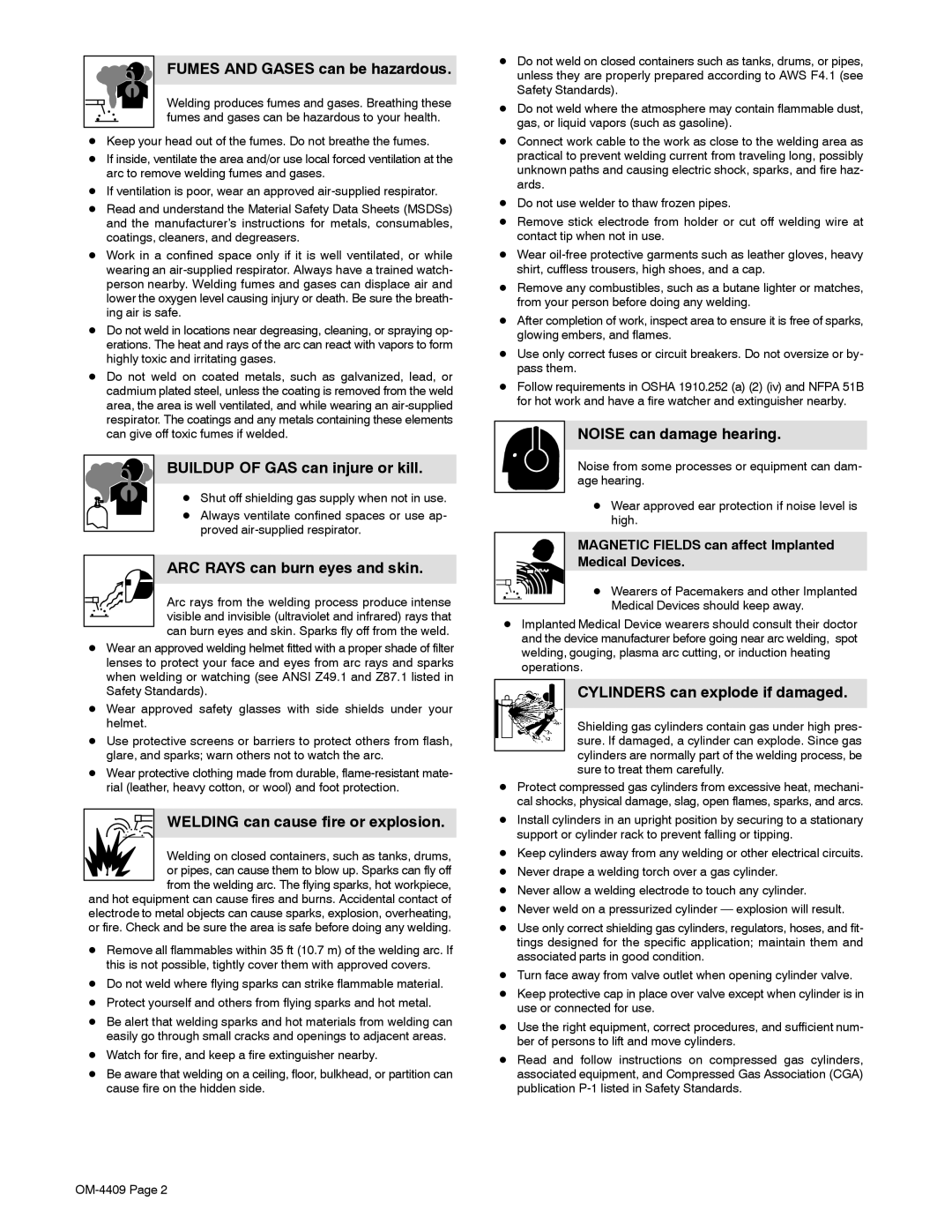FUMES AND GASES can be hazardous.
Welding produces fumes and gases. Breathing these fumes and gases can be hazardous to your health.
DKeep your head out of the fumes. Do not breathe the fumes.
DIf inside, ventilate the area and/or use local forced ventilation at the arc to remove welding fumes and gases.
DIf ventilation is poor, wear an approved air-supplied respirator.
DRead and understand the Material Safety Data Sheets (MSDSs) and the manufacturer’s instructions for metals, consumables, coatings, cleaners, and degreasers.
DWork in a confined space only if it is well ventilated, or while wearing an air-supplied respirator. Always have a trained watch- person nearby. Welding fumes and gases can displace air and lower the oxygen level causing injury or death. Be sure the breath- ing air is safe.
DDo not weld in locations near degreasing, cleaning, or spraying op- erations. The heat and rays of the arc can react with vapors to form highly toxic and irritating gases.
DDo not weld on coated metals, such as galvanized, lead, or cadmium plated steel, unless the coating is removed from the weld area, the area is well ventilated, and while wearing an air-supplied respirator. The coatings and any metals containing these elements can give off toxic fumes if welded.
BUILDUP OF GAS can injure or kill.
D Shut off shielding gas supply when not in use.
DAlways ventilate confined spaces or use ap- proved air-supplied respirator.
ARC RAYS can burn eyes and skin.
Arc rays from the welding process produce intense visible and invisible (ultraviolet and infrared) rays that can burn eyes and skin. Sparks fly off from the weld.
DWear an approved welding helmet fitted with a proper shade of filter lenses to protect your face and eyes from arc rays and sparks when welding or watching (see ANSI Z49.1 and Z87.1 listed in Safety Standards).
DWear approved safety glasses with side shields under your helmet.
DUse protective screens or barriers to protect others from flash, glare, and sparks; warn others not to watch the arc.
DWear protective clothing made from durable, flame-resistant mate- rial (leather, heavy cotton, or wool) and foot protection.
WELDING can cause fire or explosion.
Welding on closed containers, such as tanks, drums, or pipes, can cause them to blow up. Sparks can fly off from the welding arc. The flying sparks, hot workpiece,
and hot equipment can cause fires and burns. Accidental contact of electrode to metal objects can cause sparks, explosion, overheating, or fire. Check and be sure the area is safe before doing any welding.
DRemove all flammables within 35 ft (10.7 m) of the welding arc. If this is not possible, tightly cover them with approved covers.
DDo not weld where flying sparks can strike flammable material.
DProtect yourself and others from flying sparks and hot metal.
DBe alert that welding sparks and hot materials from welding can easily go through small cracks and openings to adjacent areas.
DWatch for fire, and keep a fire extinguisher nearby.
DBe aware that welding on a ceiling, floor, bulkhead, or partition can cause fire on the hidden side.
DDo not weld on closed containers such as tanks, drums, or pipes, unless they are properly prepared according to AWS F4.1 (see Safety Standards).
DDo not weld where the atmosphere may contain flammable dust, gas, or liquid vapors (such as gasoline).
DConnect work cable to the work as close to the welding area as practical to prevent welding current from traveling long, possibly unknown paths and causing electric shock, sparks, and fire haz- ards.
DDo not use welder to thaw frozen pipes.
DRemove stick electrode from holder or cut off welding wire at contact tip when not in use.
DWear oil-free protective garments such as leather gloves, heavy shirt, cuffless trousers, high shoes, and a cap.
DRemove any combustibles, such as a butane lighter or matches, from your person before doing any welding.
DAfter completion of work, inspect area to ensure it is free of sparks, glowing embers, and flames.
DUse only correct fuses or circuit breakers. Do not oversize or by- pass them.
DFollow requirements in OSHA 1910.252 (a) (2) (iv) and NFPA 51B for hot work and have a fire watcher and extinguisher nearby.
NOISE can damage hearing.
Noise from some processes or equipment can dam- age hearing.
DWear approved ear protection if noise level is high.
MAGNETIC FIELDS can affect Implanted
Medical Devices.
D Wearers of Pacemakers and other Implanted
Medical Devices should keep away.
DImplanted Medical Device wearers should consult their doctor and the device manufacturer before going near arc welding, spot welding, gouging, plasma arc cutting, or induction heating operations.
CYLINDERS can explode if damaged.
Shielding gas cylinders contain gas under high pres- sure. If damaged, a cylinder can explode. Since gas cylinders are normally part of the welding process, be sure to treat them carefully.
DProtect compressed gas cylinders from excessive heat, mechani- cal shocks, physical damage, slag, open flames, sparks, and arcs.
DInstall cylinders in an upright position by securing to a stationary support or cylinder rack to prevent falling or tipping.
DKeep cylinders away from any welding or other electrical circuits.
DNever drape a welding torch over a gas cylinder.
DNever allow a welding electrode to touch any cylinder.
DNever weld on a pressurized cylinder — explosion will result.
DUse only correct shielding gas cylinders, regulators, hoses, and fit- tings designed for the specific application; maintain them and associated parts in good condition.
DTurn face away from valve outlet when opening cylinder valve.
DKeep protective cap in place over valve except when cylinder is in use or connected for use.
DUse the right equipment, correct procedures, and sufficient num- ber of persons to lift and move cylinders.
DRead and follow instructions on compressed gas cylinders, associated equipment, and Compressed Gas Association (CGA) publication P-1 listed in Safety Standards.

